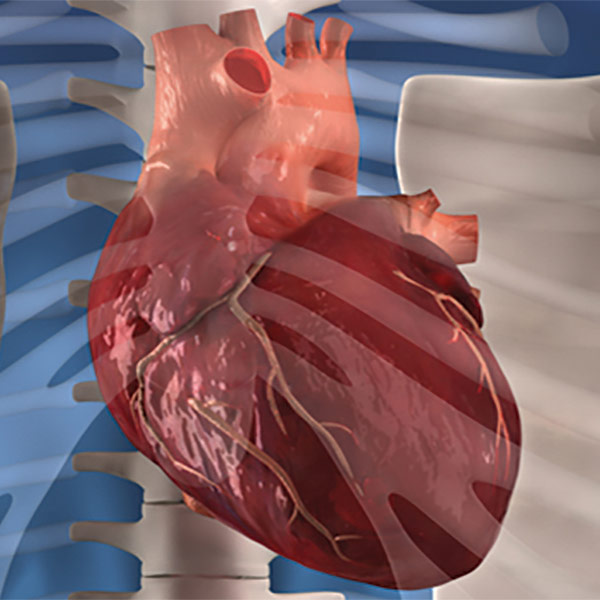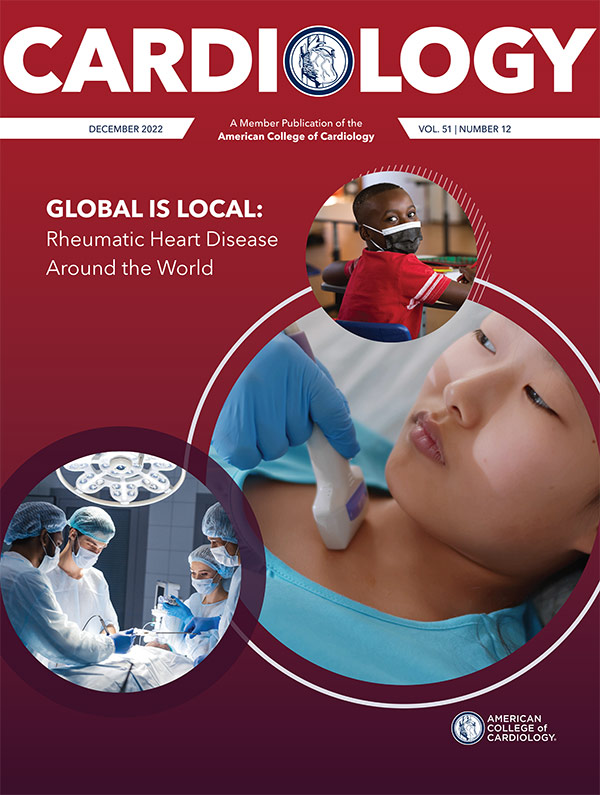Feature | Science Highlights From AHA 2022

The American Heart Association's Scientific Sessions (AHA 2022) in Chicago last month featured a host of late-breaking science, spanning the entire field of cardiology.
Check out the following highlights from some of the biggest trials presented during the meeting.
SPORT: Six Common Supplements Not as Effective as Statins to Lower LDL-C in ASCVD

Rosuvastatin at 5 mg daily lowered LDL-C significantly more than placebo, fish oil, cinnamon, garlic, turmeric, plant sterols and red yeast rice in individuals with increased 10-year risk for atherosclerotic cardiovascular disease (ASCVD), based on findings from the SPORT trial. The results were simultaneously published in JACC.
Researchers randomized 190 patients to receive 5 mg daily of rosuvastatin, placebo or one of the six common supplements used by individuals with indications for lipid-lowering therapy. The primary endpoint – change in LDL-C from baseline – was greater with rosuvastatin 5 mg daily compared with placebo and each supplement after 28 days. The difference in LDL-C reduction with rosuvastatin vs. placebo was –35.2%; none of the dietary supplements lowered LDL-C significantly more than placebo. Adverse event rates were similar across study groups, including the rosuvastatin group.
"The SPORT results and its messaging are important for public health," said Luke J. Laffin MD, FACC, who presented the findings. "Cardiologists, PCPs and others should consider using these results to have evidence-based discussions with patients."
SPYRAL HTN ON MED: Primary Endpoint Missed, Other Data Favorable

Despite showing a significant reduction in "Office BP" and a Win Ratio analysis favoring renal denervation (RDN) compared with sham, the SPYRAL HTN ON MED trial did not meet the primary efficacy endpoint of change in 24-hour systolic ambulatory blood pressure monitoring (ABPM) at six months.
The randomized trial assessed results from 337 patients at 42 sites worldwide who were part of the SPYRAL Pilot and SPYRAL Expansion groups. While falling short of meeting the endpoint, the primary safety endpoint of major adverse events at one month was met with low incidence of procedural-related and clinical adverse events, according to David E. Kandzari, MD, FACC, who presented the findings. He also noted the absolute reduction in both Office BP and ABPM for radiofrequency RDN was consistent.
According to Kandzari, the trial faced several challenges including substantial ABPM outcome differences between Pilot and Expansion groups that limited utilization of data between cohorts for Bayesian analysis. Additionally, enrollment for the Expansion group occurred over the course of the COVID-19 pandemic and "demonstrated differences in baseline ABPM patterns between pre- and during-COVID cohorts, in contrast to consistent baseline Office BP assessments."
Other limitations included disproportionate differences in both medication prescription and burden in favor of the sham group. "These imbalanced medication changes impact 24-hr ABPM more than Office BP and bias ABPM towards the null given timing of both witnessed pill intake and next day morning pill intake occurring during 24-hr ABPM," said Kandzari.
TRANSFORM-HF: Torsemide vs. Furosemide For HF

Patients treated for heart failure (HF) with the loop diuretic torsemide had similar rates of death and hospitalization compared with those treated with furosemide, a more commonly prescribed diuretic, according to results of the TRANSFORM-HF trial.
The pragmatic, open-label study randomized 2,859 patients at more than 60 U.S. hospitals to either torsemide or furosemide. Of the participants, more than one-third were women, one-third was Black, and the median age was 65 years.
Researchers also noted a broad range in the severity of HF, from recent diagnosis to worsening stages. Follow-up via phone was conducted at 30 days, six months and 12 months after hospital discharge.
After a median of 17.4 months, the rates of mortality were nearly identical in the torsemide torsemide and furosemide groups (26.1% vs. 26.2%). At 12 months, all-cause death and hospitalization rates were also similar at 47.3% and 49.3%, respectively.
Researchers noted the primary outcome demonstrating furosemide equivalence to torsemide was the same across all prespecified subgroups, including ejection fraction.
"We hoped to find that torsemide would reduce patient deaths and rehospitalizations," said lead author Robert J. Mentz, MD, FACC. "We were disappointed at first because we hoped that there would be a significant clinical difference between these two medicines based on prior studies and clinical experience. While we did not see better outcomes with torsemide, these results help inform our ability to take better care of people living with heart failure."
According to Mentz and colleagues, future work should now focus on appropriate dosing of diuretics and opportunities to address nonadherence to improve patient outcomes. They also noted the trial's pragmatic design and execution could be a model to inform future studies looking at real-world comparative effectiveness.
Among the benefits, Mentz said "broad eligibility criteria and streamlined study protocol embedded within routine care supported the inclusion of diverse participants," while pragmatic elements of the trial "lowered traditional barriers for patient and site participation."
New Insights on Drugs, Strategies For ACS and Revascularization

Drugs and strategies in managing acute coronary syndrome (ACS) and revascularization were the focus of a dedicated late-breaking science session.
Results from the BRIGHT-4 study presented by Gregg W. Stone, MD, FACC, on behalf of Yaling Han, MD, FACC, and simultaneously published in The Lancet, found that bivalirudin with a median three-hour post-PCI high-dose infusion significantly reduced the 30-day composite rate of all-cause mortality or BARC types 3-5 major bleeding vs. heparin monotherapy in Chinese patients with STEMI undergoing primary PCI with radial artery access.
"Strengths of BRIGHT-4 include its large size, few exclusion criteria, and use of radial artery access in most patients," researchers said. "Excluding patients with pre-random-assignment use of heparin or bivalirudin and restricting tirofiban use for patients with procedural thrombotic complications allowed the specific effects of bivalirudin with a post-PCI high-dose infusion and heparin monotherapy to emerge."
In OPTION, dual antiplatelet therapy (DAPT) with indobufen plus clopidogrel significantly reduced the risk of one-year net clinical outcomes in Chinese patients with negative cardiac troponin undergoing DES implantation, compared with conventional DAPT of aspirin plus clopidogrel. This difference was mainly driven by a reduction in bleeding events without an increase in ischemic events, according to Junbo Ge, MD, FACC, who presented the findings, which were also published in Circulation.
In terms of clinical implications, Ge and colleagues noted their findings suggest that aspirin replacement with indobufen on top of a P2Y12 inhibitor is feasible in patients with negative cardiac troponin undergoing coronary DES implantation. "This trial provides an important insight that could aid in decision-making for the optimal DAPT strategy in patients at high bleeding risk," they said.
ACC's Coverage of AHA 2022
Click here to access more information on these and other late-breaking trials presented at AHA 2022, as well as all of ACC's live coverage from the meeting ranging from trial summaries to video wrap-ups.
Results from PRECISE found a personalized "precision" testing approach led to more efficient evaluations for heart disease risk and improved diagnosis and treatment of coronary artery disease when compared with usual care in more than 2,000 adults with stable chest pain. Researchers compared a strategy of initial risk screening with delayed testing for low-risk participants and computed tomography for all others to a strategy without initial screening and with immediate testing for all participants to determine the need for treatment or further testing for heart disease.
"The PRECISE study provides the first randomized evidence for a risk-based testing strategy to reduce extra testing and improve efficiency of care while maintaining excellent patient outcomes, such as using guideline-directed medications, reducing chest pain and minimizing the number of heart attacks or heart disease-related deaths," said Pamela S. Douglas, MD, MACC. She added the study findings may help with chest pain evaluations by accurately identifying those who can safely delay diagnostic testing and identifying a preferred test for those who need testing.
ISCHEMIA-EXTENDed found no difference between an initial invasive strategy compared with an initial conservative strategy over a median follow-up period of 5.7 years for all-cause mortality, with nearly twice the number of deaths. The risk of cardiovascular mortality was lower and the risk of noncardiovascular mortality was higher.
These data, presented by Judith S. Hochman, MD, FACC, and published in Circulation, are a follow-up interim report of the ISCHEMIA trial, which randomized patients to an invasive strategy of routine cardiac catheterization followed by optimal revascularization with PCI or CABG surgery vs. a conservative strategy with cardiac catheterization if there was failure of optimal medical therapy. Follow-up is ongoing.
Prevention of Limb Loss Focus of Late-Breaking Science

How can we improve the prevention of limb loss through vascular interventions and venous therapies? Results from the BEST-CLI, BEST-CLI QOL, PREVENT-HD and the IMPROVE trials presented during AHA 2022 provide some clues.
In BEST-CLI, researchers compared the clinical, safety, quality of life and cost outcomes in more than 1,800 patients with chronic limb-threatening ischemia (CLTI) and infrainguinal peripheral artery disease (PAD) in two parallel-cohort trials. Patients with a single segment of great saphenous vein that could be used for surgery were assigned to Cohort 1 (n=1,434), while patients who needed an alternative bypass conduit were assigned to Cohort 2 (n=396). Thereafter, patients in Cohort 1 were randomized to bypass surgery or an endovascular procedure. Patients in Cohort 2 were randomized to bypass surgery using an arm vein or artificial blood vessel or an endovascular procedure.
The primary outcome, a composite of a major adverse limb event or death from any cause, was significantly lower among patients in Cohort 1 randomized to bypass surgery vs. an endovascular procedure. Among patients in Cohort 2, the outcomes between the surgery and endovascular subgroups were similar.
"The results we found within [Cohort 1] are interesting in that there were significantly fewer amputations and major reoperations performed in the people who had bypass surgery, and there was no difference between the treatment groups in the number of patient deaths," said Alik Farber, MD, MBA. "This information debunks the idea that CLTI patients who need revascularization should have an endovascular procedure first due to concern that bypass surgery may be potentially more dangerous. In this group of people, who were at acceptable risk for surgery and had a good vein available, we determined that surgical bypass led to better outcomes." The results were published in the New England Journal of Medicine.
BEST-QOL findings complemented the BEST-CLI clinical findings. Researchers surveyed participants at the beginning of the BEST-CLI study and at six follow-up visits over a median of four years, asking about pain, daily living activities, disease symptoms and severity, physical activity level and mental health.
Overall results found that pain scores, high at study entry, were decreased substantially and quality-of-life scores, low at study entry, increased for all participants across all measures used for assessment post surgery or procedure, driven in part by decreased leg pain.
"We anticipated low levels of quality of life at the beginning of the study," said Menard. "Improvement in health-related quality-of-life measures regardless of the type of procedure is very encouraging and highlights the importance of timely restoration of blood flow to the leg and foot."
In PREVENT-HD, early initiation of rivaroxaban, prescribed for 35 days in non-hospitalized patients with symptomatic COVID-19 at risk for thrombosis, was not found to reduce a composite endpoint of venous and arterial thrombotic events, hospitalization and death. However, in presenting the findings, Gregory Piazza, MD, MS, FACC, said a significant reduction in venous and arterial thrombotic events was observed. He also noted that bleeding overall was low and generally consistent with the known safety profile of rivaroxaban.
"With the caveat that the trial was underpowered to provide a definitive conclusion, these data do not support routine antithrombotic prophylaxis in non-hospitalized patients with symptomatic COVID-19," he said.
In IMPROVE, researchers said their findings are the first to show that a universal electronic health record (EHR)-integrated clinical decision support tool using a validated venous thromboembolism (VTE) risk model (IMPROVE-DD) significantly increased rates of in-hospital appropriate thromboprophylaxis and significantly reduced major thromboembolic events without an increase in major bleeding at 30 days post discharge compared with usual medical care.
Specifically, an approximate 50% increase was observed in appropriate thromboprophylaxis (72.5% vs. 80.1%) and researchers noted a roughly twofold increase in appropriate at-discharge extended thromboprophylaxis (7.5% vs. 13.6%). There was also a 20% reduction in VTE, 65% reduction in arterial thromboembolism (ATE), and 29% reduction in total TE (VTE + ATE, 4.0% vs. 2.9%).
"The relatively high baseline rate of appropriate in-hospital and at discharge thromboprophylaxis in academic control hospitals suggests potential for greater benefit in non-academic/community/rural hospitals," said Alex C. Spyropoulos, MD, FACC, in presenting the findings.
Clinical Topics: Acute Coronary Syndromes, Anticoagulation Management, Heart Failure and Cardiomyopathies, Prevention, Valvular Heart Disease, Vascular Medicine, Anticoagulation Management and ACS, Acute Heart Failure
Keywords: ACC Publications, Cardiology Magazine, AHA Annual Scientific Sessions, AHA22, Acute Coronary Syndrome, Heart Failure, Aneurysm, Heart Valve Diseases, Anticoagulants, Secondary Prevention
< Back to Listings

